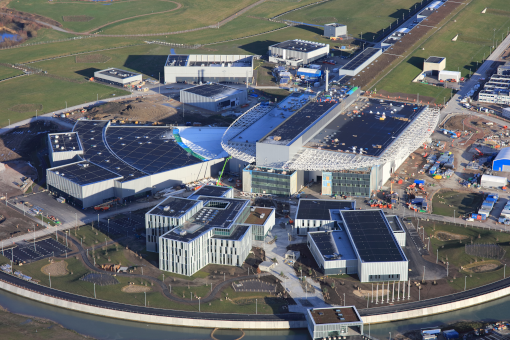The success of a project is often in the details. The European Spallation Source (ESS) in Lund is a huge construction project costing billions of Swedish crowns. ELLIIT researchers’ expertise in automatic control and microwave technology has played a key role.
“We have contributed a small but technically very tricky part here, concerned with ensuring that the proton beam is accelerated in the right way”, says Bo Bernhardsson, ELLIIT professor in automatic control at Lund University.
ESS is a European research facility under construction in Lund, with a planned inauguration for research into materials science in 2023. Spallation is the process in which the atomic nuclei of heavy metals are bombarded with protons travelling close to the speed of light. Neutrons are released and caused to penetrate the sample under investigation. When the neutrons emerge on the other side, they carry information about the sample properties. Using neutrons allows scientists to see other properties than when using X-ray technology and the
synchrotron radiation produced in, for example, the neighbouring MAX IV facility.
To accelerate the protons to a sufficiently high speed, they are passed through a 500-metre tunnel with 155 units, each of which supplies energy through powerful oscillating electromagnetic fields.
“The electromagnetic fields must be accurately controlled such that exactly the right amount of energy is supplied at the right instant. This is achieved by a control system that makes sure that the amplitudes and phases of the radio waves are always correct”, says Bo Bernhardsson.
He likens the process to a row of football players who pass the ball forwards at ever-increasing speed: if one of them misses timing the ball by as little as a millisecond, it will lose speed and shoot off at an angle instead of straight ahead.
“If the control in ESS is off kilter and gives the protons the wrong speed, they may impinge on neighbouring equipment. The equipment can become radioactive and may in the worst cases break. The facility then might have to be closed down until the radioactivity has decayed and the equipment can be changed or repaired”, Bo Bernhardsson explains.
The collaboration between ESS and the ELLIIT researchers in Lund has been led by Anders J Johansson, associate professor in the Department of Electrical and Information Technology, Lund University. The scientists have developed prototypes for the units that control the accelerator and have designed the control system in a ground-breaking digital system, constructed using a standard known as “flexible micro-TCA technology”.
“For many years, this type of facility has been designed to use analogue technology. Since the proton beam is moving close to the speed of light, digital technology was thought to be too slow. But the microTCA system is now being introduced at several facilities in the world: this has been a wise choice in which Anders J Johansson was one of the driving forces”, says Bo Bernhardsson.
In this context, the researchers have had great benefit from previous collaboration with Ericsson in milliwatt radio technology.
“Similar technical problems arise for megawatts. The technical expertise in mobile telephony available in Lund has been a great help”, Bo Bernhardsson concludes.
The algorithms used in the control system that is now to control the proton beams were developed in collaboration between ESS and the research group at Lund University. The work has resulted in a doctoral thesis by Olof Troeng with the title: “Cavity Field Control for Linear Particle Accelerators”, Lund University, 2019. Supervisors have been Bo Bernhardsson, Anders J Johansson and Rolf Johansson.
In addition to the control system, the ELLIIT researchers have also designed a system to look after the temperature control of the phase reference system that ensures that all the equipment works at precisely the right rate. It consists of a 500-metre copper tube used as a wave guide. The accelerator will have a power of 5 MW when completed and will generate a lot of waste heat. This means that the tube may expand a few millimetres if the temperature rises, giving undesired problems with synchronisation.

“The temperature variation must be kept under a tenth of a degree, and to solve this we keep the tube slightly warmer than the tunnel, using an electric coil. We can in this way keep the tube at exactly the same temperature all the time”, says Bo Bernhardsson The researchers made their proposals in a report, giving details of what is possible and how much it would cost. The proposals were positively received, and the solution is now implemented.
Research Group
Research
Bo Bernhardsson, professor, Division for Automatic Control. Anders J Johansson, docent, Department of Electrical and Information Technology. Rolf Johansson, professor, Division for Automatic Control. Olof Troeng, doctor, Division for Automatic Control all of them at Lund University.

